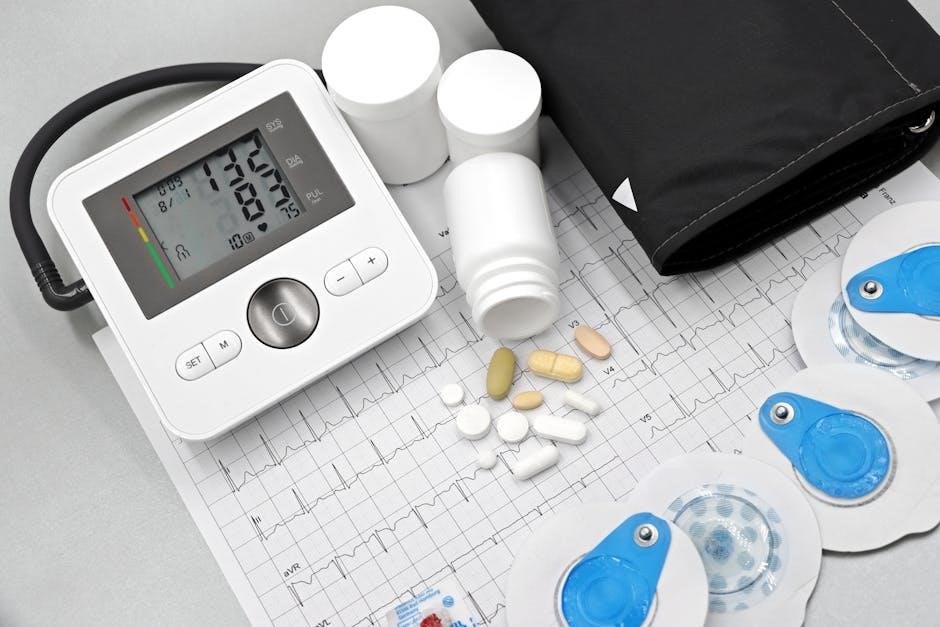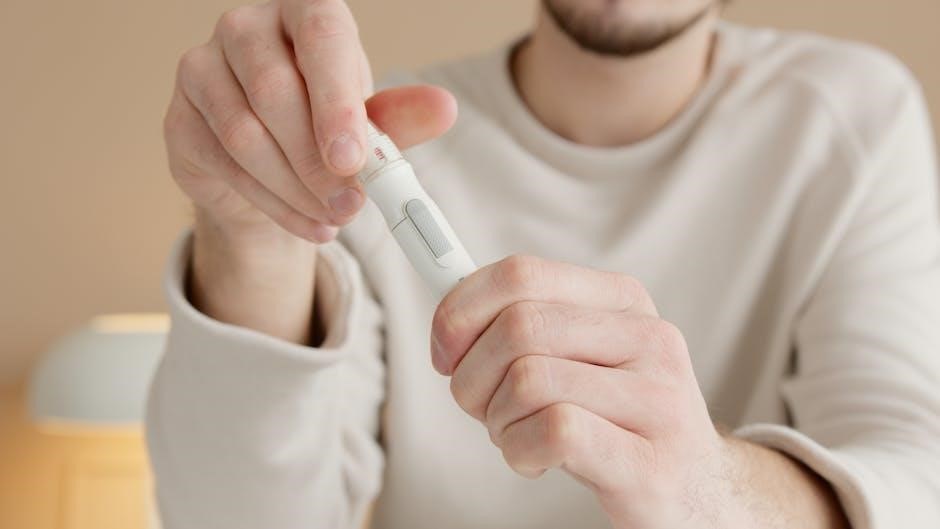A diabetic foot exam is a critical assessment for early detection of foot-related complications in diabetic patients. It involves evaluating sensory, vascular, and structural integrity using tools like monofilaments and Dopplers. Regular exams prevent severe outcomes such as ulcers and amputations, emphasizing the importance of adherence to clinical guidelines like those from IWGDF and NICE.
Overview of Diabetic Foot Syndrome
Diabetic foot syndrome (DFS) encompasses a range of complications affecting the feet of individuals with diabetes, primarily due to neuropathy and peripheral artery disease. These conditions often lead to loss of sensation, poor circulation, and impaired wound healing. Untreated, DFS can progress to foot ulcers, infections, and even amputations. Early detection is critical, as foot disorders are a leading cause of hospitalization and healthcare costs for diabetic patients. The syndrome is closely linked to glycemic control, with elevated blood sugar levels exacerbating nerve and vascular damage. Regular foot exams are essential to identify risk factors and prevent severe outcomes, emphasizing the importance of proactive management and adherence to clinical guidelines.
Importance of Regular Foot Exams for Diabetic Patients
Regular foot exams are vital for diabetic patients to detect early signs of complications such as ulcers, infections, and neuropathy. Early detection significantly improves outcomes, preventing progression to severe conditions. Foot exams enable healthcare providers to assess sensory and vascular health, identify high-risk areas, and implement timely interventions. According to clinical guidelines, annual comprehensive foot evaluations are recommended for all diabetic patients. These exams not only reduce the risk of amputations but also lower healthcare costs associated with prolonged treatments. By incorporating foot exams into routine care, patients can maintain mobility and quality of life, emphasizing the critical role of preventive measures in diabetes management.

Key Components of a Diabetic Foot Exam
A comprehensive diabetic foot exam includes medical history review, physical foot inspection, sensory testing with monofilaments, vascular assessment using Dopplers, and neurological evaluation to detect complications early.
Medical History and Risk Assessment
Medical history and risk assessment are foundational in a diabetic foot exam. Evaluating the patient’s diabetes duration, prior foot ulcers, amputations, and comorbidities (e.g., neuropathy, peripheral artery disease) is essential. Lifestyle factors, such as smoking and footwear habits, are also considered. Clinical tools like monofilaments and Dopplers aid in identifying neuropathy and vascular issues. Assessing glycemic control (HbA1c) helps predict wound healing potential. Risk categorization guides preventive measures, such as custom footwear or intensive monitoring. Early detection of high-risk patients enables timely interventions, reducing complications. This step ensures personalized care plans, emphasizing prevention and management strategies tailored to individual needs.
Physical Examination of the Feet
The physical examination of the feet in a diabetic foot exam involves a thorough inspection for signs of ulcers, deformities, or infections. Clinicians check for calluses, redness, swelling, and warmth, which may indicate pre-ulcerative or infected areas. Palpation of pedal pulses assesses circulation, while monofilament testing evaluates sensory perception. The presence of fungal infections like onychomycosis or tinea pedis is also noted. Gait and balance are observed to identify biomechanical issues. Photographs of high-risk areas are often taken for monitoring. This comprehensive assessment helps identify early signs of complications, guiding appropriate referrals and interventions. Regular physical exams are crucial for preventing progression to severe foot ulcers or amputations.
Neurological and Vascular Assessment
The neurological assessment evaluates peripheral neuropathy using a 10-gram monofilament and vibration testing to detect sensory loss. Vascular evaluation involves Doppler assessment to check blood flow and identify ischemia. Palpation of pedal pulses and capillary refill time provides additional insights into circulation. These assessments are critical for early detection of neuropathy and peripheral artery disease, which are key risk factors for diabetic foot complications. Regular monitoring ensures timely intervention, preventing severe outcomes like ulcers and amputations. Accurate documentation of findings guides targeted treatment and improves patient outcomes, emphasizing the importance of these assessments in comprehensive diabetic foot care.

Diagnostic Tools and Techniques
Key tools include monofilament testing for sensory loss, Doppler assessment for vascular evaluation, and foot screening forms to document findings, ensuring comprehensive foot evaluation.
Use of Monofilament for Sensory Testing
The monofilament test is a cornerstone in diabetic foot exams to assess sensory perception. A 10-gram monofilament is applied to specific foot areas to evaluate nerve sensitivity. Patients unable to feel the filament indicate peripheral neuropathy, a key risk factor for foot ulcers. This simple, non-invasive tool is widely recommended in clinical guidelines for early detection of neuropathy. Regular use ensures timely identification of sensory loss, enabling preventive measures to avoid complications. The test is part of a comprehensive foot evaluation, alongside other diagnostic tools, to ensure optimal patient outcomes and reduce the risk of severe diabetic foot conditions.
Doppler Assessment for Vascular Evaluation
Doppler assessment is a vital component of vascular evaluation in diabetic foot exams. It uses sound waves to measure blood flow, detecting conditions like peripheral artery disease. This non-invasive method helps identify areas of reduced circulation, which can impair wound healing. Regular Doppler use, as per IWGDF guidelines, aids in early detection of vascular issues, preventing severe complications. It complements monofilament testing by providing a comprehensive view of foot health, ensuring timely interventions to manage diabetic foot conditions effectively.
Foot Screening Tools and Forms
Foot screening tools and forms are essential for systematic evaluation of diabetic patients. The Diabetes Foot Screening Tool, mentioned in clinical guidelines, aids in assessing risk factors and detecting early signs of complications. These tools often include checklists for visual inspection, sensory testing, and vascular assessment. Forms like the Podiatry Diabetic Foot Assessment Form guide healthcare providers through comprehensive foot exams, ensuring consistency and thoroughness. Regular use of these tools enhances early detection of issues, facilitating timely interventions and improving patient outcomes. They are integral to implementing evidence-based practices recommended by organizations like the IWGDF and NICE, ensuring effective diabetes foot care;

Classification and Staging of Diabetic Foot Ulcers
Diabetic foot ulcers are classified using systems like the Wagner and University of Texas classifications, which predict healing rates and guide clinical decisions, aiding effective treatment planning.
Wagner Classification System
The Wagner Classification System is a widely used method for categorizing diabetic foot ulcers based on their depth and presence of infection or ischemia. It consists of six grades, ranging from Grade 0 (no ulcer) to Grade 5 (extensive gangrene). This system helps clinicians determine the severity of ulcers and guide appropriate treatment, improving outcomes by standardizing communication and management strategies. Regular use of this classification in diabetic foot exams ensures consistent assessment and documentation, aiding in tracking progression and response to therapy. Early detection and staging are crucial for preventing complications and optimizing patient care.
University of Texas Diabetic Wound Classification
The University of Texas Diabetic Wound Classification system provides a detailed framework for categorizing diabetic foot ulcers. It focuses on ulcer depth and the presence of infection or ischemia, offering a comprehensive approach for clinical assessment. This system helps guide treatment decisions, monitor wound progression, and improve patient outcomes by ensuring standardized documentation; Regular use in diabetic foot exams facilitates accurate staging and timely interventions, reducing the risk of severe complications. By integrating this classification, healthcare providers can enhance communication and optimize care strategies, ultimately improving wound healing rates and overall patient management.

Prevention and Management Strategies
Prevention involves lifestyle modifications, regular foot exams, and optimal blood sugar control. Management includes wound care, treating neuropathy, and timely referrals to specialized care for complications.
Lifestyle Modifications and Foot Care
Lifestyle changes and proper foot care are essential for preventing diabetic foot complications. Regular foot exams, proper footwear, and avoiding smoking are crucial. Patients should maintain a healthy diet, exercise regularly, and manage blood sugar levels to prevent neuropathy and vascular issues. Daily foot inspections for cuts, blisters, or calluses are vital, and toenails should be trimmed correctly to avoid infections. Wearing well-fitting shoes and moisture-wicking socks can reduce friction and promote foot health. Additionally, patients should avoid walking barefoot and keep feet clean and dry. These practices, combined with professional guidance from podiatrists, help prevent ulcers and infections, ensuring long-term foot health and Mobility. Early intervention by healthcare providers is key to managing risks effectively.
Role of Podiatrists and Practice Nurses
Podiatrists and practice nurses play a pivotal role in diabetic foot care, often working together to provide comprehensive assessments and management. They conduct thorough foot exams, checking for signs of neuropathy, vascular issues, and structural abnormalities. Podiatrists specialize in treating foot conditions, such as ulcers and infections, while practice nurses focus on overall diabetes management and preventive care. They educate patients on proper foot hygiene, footwear selection, and lifestyle modifications to prevent complications. Regular check-ups and early intervention are crucial, and these professionals ensure adherence to clinical guidelines, improving patient outcomes and reducing the risk of severe complications like amputations. Their collaborative efforts are essential for optimizing diabetic foot health and promoting long-term patient well-being.

Clinical Guidelines and Recommendations
Clinical guidelines emphasize early detection and intervention in diabetic foot care. The International Working Group on the Diabetic Foot (IWGDF) and NICE provide evidence-based recommendations.
Annual foot exams, monofilament testing, and Doppler assessments are crucial. These guidelines aim to prevent complications, improve outcomes, and reduce amputation rates through standardized care practices.
International Working Group on the Diabetic Foot (IWGDF) Guidelines
The IWGDF guidelines provide comprehensive strategies for diabetic foot care, emphasizing prevention, early detection, and evidence-based treatment. They recommend regular foot exams, use of monofilaments for sensory testing, and Doppler assessments for vascular evaluation. The guidelines highlight the importance of classifying ulcers using systems like Wagner or University of Texas to guide treatment. They also stress multidisciplinary care, involving podiatrists, nurses, and specialists. Key recommendations include optimizing glycemic control, managing neuropathy, and promoting wound care to prevent amputations. These guidelines serve as a global standard, aiming to improve outcomes and reduce the burden of diabetic foot complications worldwide. Adherence to IWGDF guidelines is associated with better patient survival and cost-effectiveness in managing diabetic foot disease.
NICE Guidelines for Diabetic Foot Care
NICE guidelines emphasize early detection and management of diabetic foot complications to prevent amputations and improve patient outcomes. They recommend regular foot exams, risk assessment, and prompt treatment of ulcers or infections. The guidelines advocate for a multidisciplinary approach, involving podiatrists, nurses, and specialists. Key recommendations include prompt referral to foot protection services for high-risk patients and the use of validated tools for neuropathy and vascular assessment. Patient education on foot care and lifestyle modifications is also stressed. These guidelines aim to ensure cost-effective, evidence-based care, reducing the burden of diabetic foot disease and enhancing quality of life for patients.
Early detection and intervention in diabetic foot exams significantly improve outcomes, reducing complications. Future advancements in screening tools and adherence to clinical guidelines will enhance care effectiveness globally.
Impact of Early Detection and Intervention
Early detection and timely intervention in diabetic foot exams are crucial for preventing severe complications. Identifying issues like neuropathy or poor circulation early can significantly reduce the risk of ulcers and amputations. Studies show that adherence to screening protocols, such as those recommended by the IWGDF, improves patient outcomes and lowers healthcare costs. Regular foot assessments enable healthcare providers to address potential problems before they escalate, emphasizing the importance of routine check-ups for diabetic patients. This proactive approach not only enhances quality of life but also reduces the economic burden associated with advanced foot complications.
Advancements in Diabetic Foot Care
Recent advancements in diabetic foot care have revolutionized the management of foot-related complications. The integration of handheld nerve conduction devices, such as the DPN Check, enables precise assessment of neuropathy severity. Enhanced Doppler technologies improve vascular evaluation, aiding early detection of ischemia. Telemedicine platforms now facilitate remote foot monitoring, expanding access to care. Additionally, multidisciplinary care approaches, combining podiatrists, nurses, and vascular specialists, have shown improved outcomes. Innovations in wound healing, including advanced dressings and bioengineered tissues, accelerate recovery. These advancements, coupled with streamlined screening protocols, emphasize the importance of early intervention and personalized treatment plans, ultimately reducing amputation rates and enhancing quality of life for diabetic patients.
